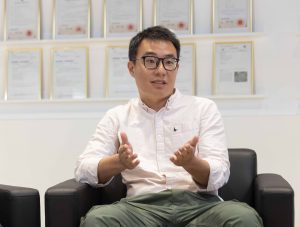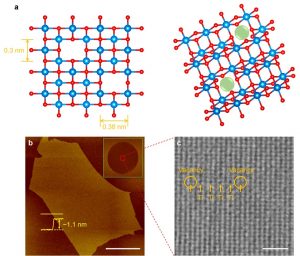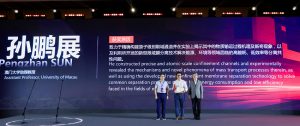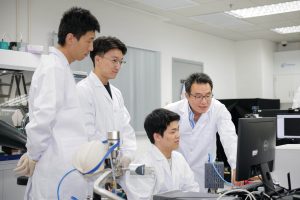In the microscopic world of the atomic scale, matter exhibits behaviours that challenge conventional understanding, revealing transport phenomena that are nothing short of extraordinary. Sun Pengzhan, assistant professor in the Institute of Applied Physics and Materials Engineering at the University of Macau (UM), has not only unravelled the scientific principles behind these phenomena, but also applied them to develop cutting-edge separation technologies. These innovations offer promising solutions to one of the biggest challenges in the energy sector: reducing energy consumption while improving efficiency. Prof Sun’s groundbreaking work earned him a spot on MIT Technology Review’s ‘35 Innovators Under 35’ list, recognising him as a rising star in Macao’s research community. From his early years at Tsinghua University to working under the mentorship of a Nobel laureate, Prof Sun’s journey has been driven by an unwavering passion for scientific discovery. He is deeply committed to exploring fundamental questions in science and paving the way for transformative applications in the future.
Unveiling the power of the invisible
In Prof Sun’s lab at UM, he and his team are often gathered around an electron microscope, their eyes fixed on a screen showing something almost invisible: a transparent membrane merely one atom thick. This is their groundbreaking creation—a novel ultra-thin proton-conducting membrane made with angstrom-porous titania. Inspired by his fascination with the subtle behaviour of proton transport, this innovation embodies Prof Sun’s belief that ‘breakthrough applications often grow from a deep understanding of fundamental scientific questions.’ This mindset drives his tireless exploration of microscopic spaces, where even the tiniest particles can unlock transformative technologies.
This ultra-thin membrane acts as an exceptionally precise and durable molecular sieve. It can selectively conduct protons at high temperatures while completely blocking other gases and ions—a breakthrough that overcomes the flaws of materials like graphene, which degrade under heat and have low conductivity. This innovation has led to a significant improvement in the performance of commercial proton membranes, achieving more than a tenfold increase in efficiency. It has also opened new possibilities for high-temperature fuel cell technology. Looking to the future, this advancement could revolutionise applications such as hydrogen-powered vehicles and decentralised energy systems, offering longer lifespans, better resilience to environmental challenges, and lower operational costs.
What is even more remarkable is that this membrane is not just a concept confined to the lab. Using a technique called ‘layer-by-layer electrostatic assembly’, the membrane can be produced at scale, making it ready for industrial use. Since joining UM in 2022, Prof Sun has guided his team through intense research and development, successfully overcoming bottlenecks. Their membrane now surpasses international standards for proton conductivity and offers a fresh perspective on the future of hydrogen fuel cell technology.
Where formulas meet curiosity
Prof Sun’s fascination with the microscopic world began during his undergraduate years at Tsinghua University. In 2008, he enrolled in the Department of Mechanical Engineering. In his second year, a pivotal moment came when he discovered the book Carbon Nanotubes by Prof Zhu Hongwei. This book opened the door to the captivating world of carbon nanomaterials and introduced him to a profound principle: structure determines properties. For Sun, it was a revelation. He realised that the true beauty of materials science was not in large-scale manufacturing, but in the invisible laws and equations that govern matter at the atomic level. ‘I wasn’t particularly drawn to mechanical design,’ Prof Sun recalls. ‘What fascinated me were the physical and chemical principles behind the formulas—the elegance of predicting how materials behave through fundamental principles and understanding the laws of nature at the atomic scale. It felt like art.’
This realisation prompted Sun to make a bold academic shift. For his doctoral studies, he transferred to the School of Materials Science and Engineering at Tsinghua, where he focused on the microscopic mechanisms of two-dimensional materials. This move was not just a change of major; it was a commitment to turning his curiosity into a lifelong pursuit. ‘Exploring these phenomena felt like solving an atomic-scale puzzle with an artistic touch,’ he says with a smile. ‘After final exams, I’d head straight to the lab. I didn’t even want to leave during holidays.’
In just eight years, Sun completed both his undergraduate and doctoral studies at Tsinghua. Reflecting on that time, he considers the clarity he gained about his research direction to be his most significant achievement. During his PhD studies, he focused on the separation mechanisms of graphene oxide membranes and noticed that existing explanations about microscopic transport pathways were often vague. This sparked his drive to think critically about established ideas and prompted him to investigate the inconsistencies he encountered. Eventually, Sun turned his attention to a fundamental question: how do different ions pass through graphene? Sun’s dedication to uncovering the underlying principles of material behaviour led him to the University of Manchester in 2016, where he studied under Nobel laureate Andre K. Geim. There, he embarked on a new chapter of his career, pioneering fresh approaches to the study of two-dimensional materials.
The sense of aesthetics in scientific inquiry
At the University of Manchester, Sun experienced a turning point in his scientific journey. ‘If your goal is just to publish papers, this isn’t the place for you,’ Prof Geim would often remind his students—a mantra that profoundly shaped Sun’s approach to research. It was a call to focus on the essence of scientific problems rather than chasing publishable results. Joining one of the world’s top research teams, Sun immediately felt the pressure. Surrounded by brilliant minds, he knew he had to prove himself. ‘I was very clear about one thing,’ he says. ‘I had to show what I was capable of.’
Then the pandemic hit. Forced out of the lab, Sun unexpectedly found opportunity in isolation. With time to focus, he immersed himself in analysing experimental data, uncovering subtle patterns that had previously gone unnoticed. His analysis led to a fresh interpretation of how gas molecules behave when transported through atomically thin two-dimensional channels. He compiled his insights and preliminary analysis into a report and sent it to Prof Geim.
The report sparked a series of intense, hours-long daily discussions between Sun and Prof Geim, ultimately leading to the formation of a research team that aimed to solve a critical challenge in gas separation using two-dimensional materials. Yet for Sun, the most profound outcome was not the publication; it was the development of a new kind of intuition: a sense of aesthetic judgment in science.
‘I learned to tell the difference between what’s truly important and what just seems popular,’ Prof Sun reflects. ‘That kind of instinct is like having taste in research.’ Inspired by the artistic philosophy of his favourite painter, Mu Xin, Sun came to believe that the pursuit of beauty and essence lies at the heart of original innovation. ‘Without that sense of aesthetics,’ he says, ‘even the most extensive knowledge might not be enough to guide you.’
MIT’s recognition: A reminder of the true value of research
Despite his rigorous training at Tsinghua University and the University of Manchester, Prof Sun faced a challenge common to many early-career researchers: attracting top students to a newly established lab. ‘No matter how refined your scientific taste is,’ he says, ‘you still need teammates to get the work done.’ This practical need inspired him to apply for the MIT Technology Review’s ‘35 Innovators Under 35’ list—not just for the honour, but to build visibility and attract young talent to join his team.
Renowned for its stringent selection process and focus on transformative technologies, the list was not something Prof Sun initially pursued with high expectations. ‘A friend suggested I apply, saying it’s a fast track to recognition in the academic world,’ he recalls. ‘I didn’t think much of it at first.’ But true innovation speaks for itself. Prof Sun’s pioneering discoveries on molecular transport in two-dimensional materials offered critical theoretical support for breakthroughs in clean energy, ultimately earning him a spot among the 35 Chinese honourees in 2023. Moreover, Prof Sun was the only recipient from Macao recognised that year.
The award brought increased attention and resources, but Prof Sun remained grounded. ‘MIT’s recognition is like a mirror. It reflects what real innovation should be,’ he says. For Prof Sun, the award was not about publication calculations, but about having the courage to challenge conventional frameworks—a philosophy deeply influenced by the ‘scientific taste’ he developed during his time in the UK. More than just an accolade, the experience opened unexpected doors. Through MIT’s cross-disciplinary exchanges, Prof Sun engaged in thought-provoking conversations with innovators from fields like artificial intelligence, biomedical engineering, and information science.
‘I realised the true value of the award isn’t the title—it’s the chance to exchange ideas with brilliant, unconventional minds,’ Prof Sun reflects. One of those conversations sparked a pivotal moment. During a discussion with a postdoctoral researcher working on brain-computer interfaces, Prof Sun was asked, ‘Why not apply your ion-selective membranes to neural signal transmission?’ That simple question ignited a new line of thinking and reshaped his vision for future research.
Today, at UM, Prof Sun leads a dynamic research team composed of young students and scholars. Together, they are exploring how ion transport mechanisms can be applied to neuromorphic devices, aiming to overcome the energy bottlenecks in traditional computing. ‘The true value of science isn’t found in the glow of awards,’ he concludes, ‘but in the enduring curiosity and drive to explore the unknown. Recognition is just one chapter in the journey. What truly matters is your ability to continue asking meaningful questions.’
‘Digging a riverbed’: A guiding research philosophy
Prof Sun often compares fundamental research to digging a riverbed: the aim is not to hasten the flow of water to the sea, but to ensure that the channel is deep, sturdy, and well-formed. This philosophy is reflected in his work on atomic-scale transport mechanisms, where he focuses on establishing solid scientific foundations that allow future breakthroughs to flow naturally. Such a long-term vision requires an environment that fosters intellectual freedom, and Prof Sun has found that at UM. ‘UM’s trust and openness allow researchers to navigate seamlessly between fundamental and applied science,’ he explains. ‘It gives us the space to follow our own research rhythm, explore new dimensions, and discover unexpected possibilities through interdisciplinary collaboration.’
Profile of Prof Sun Pengzhan
Prof Sun Pengzhan is assistant professor in the Institute of Applied Physics and Materials Engineering at the University of Macau. He earned his bachelor’s degree in Mechanical Engineering and Automation in 2012, and his PhD in Materials Science and Engineering in 2016, both from Tsinghua University. His research primarily focuses on the mechanisms and applications of molecular transport in strongly confined environments. In recent years, he has also focused on constructing nano- to sub-nanoscale confined channels with two-dimensional separation membranes, and investigating the selective transport behaviours of ions, atoms, and molecules. His research findings have been published in leading international journals, including Nature, Proceedings of the National Academy of Sciences, Nature Communications, and Science Advances. Prof Sun has received numerous prestigious honours, including the Excellent Young Scientists Fund (Hong Kong and Macao) from the National Natural Science Foundation of China, the Materials Research Society (MRS) Graduate Student Award, and Top Scholarship from Tsinghua University.
Chinese Text: U Wai Ip, Senior UM Reporter Deng Liyu
Chinese Editor: Gigi Fan
English Translation: U Wai Ip
English Editor: Bess Che
Photo: UM Reporter Yang Ruiqi, with some provided by the interviewee
Source: My UM Issue 147

Prof Sun Pengzhan

Prof Sun and his team have developed a novel ultra-thin proton-conducting membrane made with angstrom-porous titania

Prof Sun is named one of the ‘35 Innovators Under 35’ by MIT Technology Review

Prof Sun describes MIT’s recognition as a mirror, reflecting what true innovation should be

Prof Sun leads his team in interdisciplinary research

Prof Sun has brought together a group of young scholars and researchers at UM to build a dynamic research team
